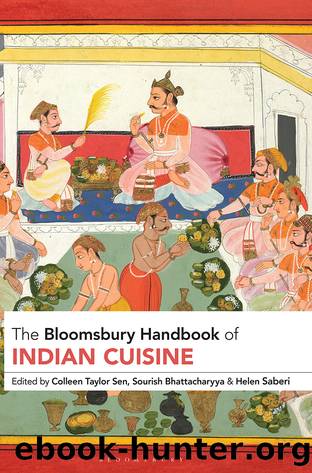The Bloomsbury Handbook of Indian Cuisine by Sen Colleen Taylor;Bhattacharyya Sourish;Saberi Helen;

Author:Sen, Colleen Taylor;Bhattacharyya, Sourish;Saberi, Helen;
Language: eng
Format: epub
Publisher: Bloomsbury Publishing Plc
Published: 2023-03-03T00:00:00+00:00
Figure 31 MAHARASHTRA. Vada pav. Srishti Gurung/Wikimedia Commons.
Translated as âthe mighty landâ, Maharashtra is the third largest state in India by area and the second largest in population. It was formed in 1960 by dividing the bilingual Bombay State into majority Marathi-speaking Maharashtra and Gujarati-speaking Gujarat. The vastness of Maharashtra suggests that there are many differences in topography, and therefore in products and styles of food. Maharashtra can be divided into several regions:
Konkan. Raigad, Ratnagiri, Sindhudurg, Thane and MUMBAI are the districts along the coastal belt of Maharashtra, called Konkan. Lined by the Arabian Sea from north to south, the produce of the Konkan is similar throughout, but the variety of cuisines available in this region is impressive. The different communities use the primary crops available to them â COCONUT, RICE, FISH, KOKUM and plantains â in different ways to create distinct flavours. The many varieties of GOURDS and CUCUMBERS available along the coast are used not only in CURRIES but also as bhareet (a sort of cold, mashed salad) and are also made into desserts. An example is bhoplyaache ghaarge, a sweetened unleavened fried bread made from pumpkin and jaggery.
Saltwater fish and crustaceans are made in a variety of ways using fresh or dried coconut as a base or without any coconut at all. Community-specific spice mixes (see SPICE BOX) define the flavours of a dish, and curries are usually eaten with local varieties of short-grain rice or bhakri, flatbreads made from rice or sorghum. In the Malvan and adjacent regions, chicken and mutton curries are relished with deep-fried multigrain BREADS called vade. MANGO, JACKFRUIT, BANANA and other fruits are abundant and are used both raw and ripe. Raw mangoes are used as souring agents for amti (lentil curries) and fish curries or in salads; raw jackfruit is stir-fried or curried to make a side dish; and raw bananas are milled to make flour to make thalipeeth (skillet flatbreads) which are part of fasts. Ripe fruits are also used in cooking, proving that the region really loves its ambat-goad or sweet and sour flavour profile as much as it loves its hot and spicy one.
Desh (Western Maharashtra) covers the plateau region and includes Pune, Satara, Karad, Kolhapur and other cities. It was the centre of the Maratha Empire and is now a major education and IT hub. Peanuts are a very important crop, used in cooking and pressed for oil. Toor dal (split pigeon pea) is more commonly eaten than other legumes (see PULSES), and sorghum and pearl millet (see MILLETS) are essential carbohydrates. Figs, GUAVA and other fruits grow in plenty. Sugarcane is another important crop; jaggery and its by-product, kaakvi or sugarcane molasses, are preferred to refined SUGAR.
Kolhapur and Pune preserve remnants of their regal pasts. Kolhapuri cuisine is characterized by a sophisticated use of spices and was once known for its game meat. Pune was once the home of the Peshwas, who were Brahmins, and many commercial Pune eateries also serve the vegetarian fare of the community.
Download
This site does not store any files on its server. We only index and link to content provided by other sites. Please contact the content providers to delete copyright contents if any and email us, we'll remove relevant links or contents immediately.
The Official Cookbook of the Chile Pepper Institute by Paul W. Bosland(223)
Alaska Sourdough, Revised Edition by Ruth Allman(186)
Southern Inspired by Jernard A. Wells(174)
Y'all Eat Yet? by Miranda Lambert(166)
The Gilded Age Cookbook by Becky Libourel Diamond(161)
Borealis Breads by Jim Amaral & CYNTHIA FINNEMORE SIMONDS(158)
New England Soups from the Sea by Craig Fear(144)
In Love with New York by Nieschlag Lisa;Wentrup Lars; & Lars Wentrup(141)
Chili madness : a passionate cookbook by Butel Jane(140)
Makini's Vegan Kitchen by Makini Howell(136)
Pulp by Abra Berens(135)
Truly Texas Mexican by Adán Medrano(134)
Easy Southern Vegan Cookbook: Plant-Based Recipes for Classic Favorites by Gardner Troy(130)
The Justin Wilson Cookbook by Unknown(129)
Southwest Table by Dave Dewitt(128)
My Vermont Table by Gesine Bullock-Prado(127)
The Kansas City Barbeque Society Cookbook by Ardie A. Davis(123)
The Complete Chile Pepper Book: A Gardener's Guide to Choosing, Growing, Preserving, and Cooking by Bosland Paul W. & DeWitt Dave(120)
Forage. Gather. Feast. by Maria Finn(118)
